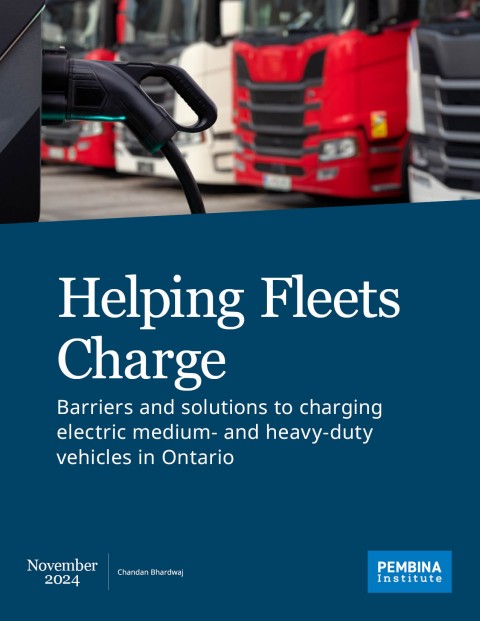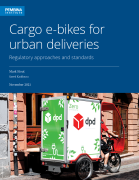Electrifying the medium- and heavy-duty (MHDV) sector offers significant benefits for Ontario and every region of Canada that embraces the transition. Shifting to electric strengthens the economy, improves public health, and reduces costs for vehicle owners and operators.
Economic importance of MHDVs
Road-freight transport, dominated by MHDVs, is essential for economic growth and trade in Ontario and across Canada’s broader economy. However, the sector’s heavy reliance on fossil fuels comes at a high cost — MHDVs account for 50% of on-road emissions despite representing only 10% of vehicles, contributing CAD$120 billion in annual pollution-related health expenses and over 15,000 premature deaths each year.
Electrifying MHDVs offers a path to economic renewal by:
- Lowering fuel and maintenance costs for operators.
- Creating demand for Canada’s mining industry.
- Revitalizing jobs in the shrinking MHDV manufacturing sector.
All of this, while improving public health and reducing environmental impacts.
Overcoming barriers to adoption of electric MHDVs
Realizing these opportunities requires addressing the challenges around electric MHDV charging infrastructure — an essential step towards achieving widespread adoption of electric MHDVs. Our report explores the barriers to building this infrastructure and outlines regulatory solutions to accelerate the deployment of charging infrastructure for MHDVs.
Barriers to charging infrastructure deployment
Our research and extensive engagement with fleets and utilities identified key barriers to the efficient deployment of MHDV charging infrastructure in Ontario:
- The cost of purchasing and installing charging equipment is prohibitive, particularly for small fleet operators with limited budgets.
- The lack of familiarity with electric MHDVs leads to hesitancy in both purchasing these vehicles and investing in necessary infrastructure.
- High electricity delivery rates weaken the business case for public charging infrastructure, as low uptake of electric road freight results in idle stations that cannot offset costs.
- Many local electricity distribution systems require upgrades to handle increased electric MHDV-induced energy demands, but utilities are often restricted to justifying investments based on past usage rather than future needs.
- Cumbersome approval processes, involving multiple agencies and duplicated efforts, delay the integration of electric vehicles into the grid.
- The absence of uniformity across charging stations, leading to multiple, often incompatible charger connectors creates uncertainty among users about technology choice, and in turn delays investments in public charging stations.
Our recommendations
To address the barriers identified above, we recommend the following actions:
- The Government of Ontario revive the Electric Vehicle ChargeON program (Community Stream) by at least two more years to fund the installation of public chargers in communities outside of major cities.
- The Ontario Energy Board (OEB) require utilities to provide publicly accessible information about electric vehicles and grid connection processes to fleet and charging station operators.
- The OEB empower utilities to make forward-looking investments in system upgrades to accommodate the anticipated rise in electricity demand from electric MHDVs. This may include updating the Distribution System Code and facilitating the use of localized, forward-looking MHDV traffic data by utilities to allow future investments.
- The OEB allow utilities to offer reduced billing rates to public charging station operators, such as by reducing demand charges on delivery rates.
- The OEB continue to streamline the regulatory process for public chargers and include municipalities in the Distributed Energy Resources working group, while developing a single-window approval system for installing electric MHDV charging stations.
- The Government of Ontario, in collaboration with the Ontario Electrical Safety Authority and the Canadian Standards Association, establish uniform standards for all new charging stations.
- Fleet owners planning to install private depot chargers and network operators intending to install public charging stations connect with their local utilities early in the planning stage to allow adequate time for electrical upgrades and demand side management.
For detailed insight on barriers and solutions, refer to Pembina Institute’s report Helping Fleets Charge: Barriers and solutions to charging electric medium- and heavy-duty vehicles in Ontario, available for download at the top of this page.
Ongoing efforts to support the transition
The Pembina Institute’s commitment to supporting the transition to electric MHDVs drives our ongoing efforts to address barriers and build on our recommendations. Through the upcoming Grid Readiness project, launched with support from FedEx, we will help municipalities and utilities in the Greater Toronto and Hamilton Area map optimal locations for commercial freight charging stations and forecast energy loads. And through our ongoing awareness-raising work, we are addressing gaps in fleet owner and operator awareness about electric MHDVs.




